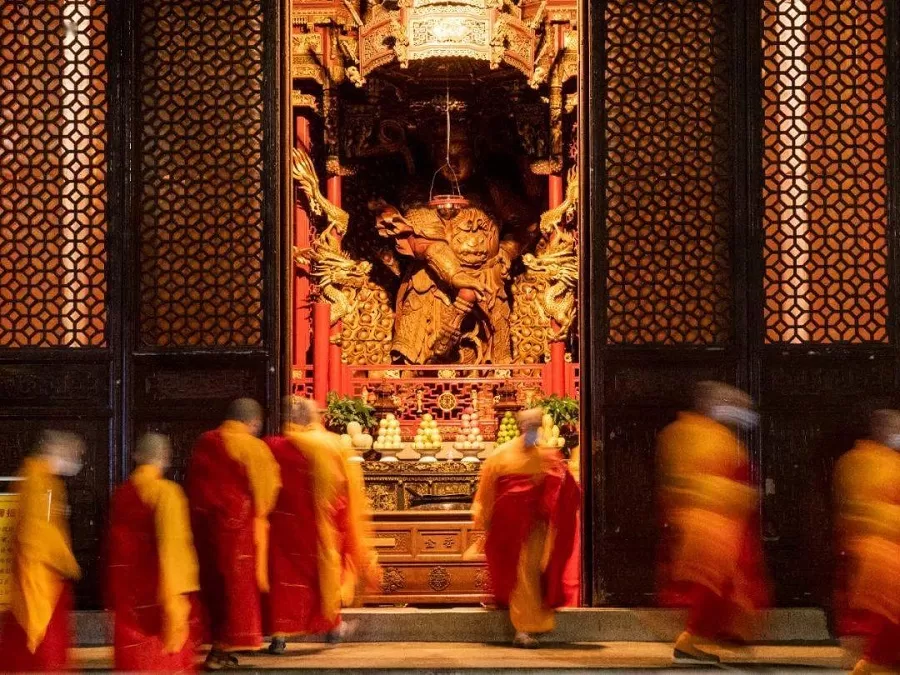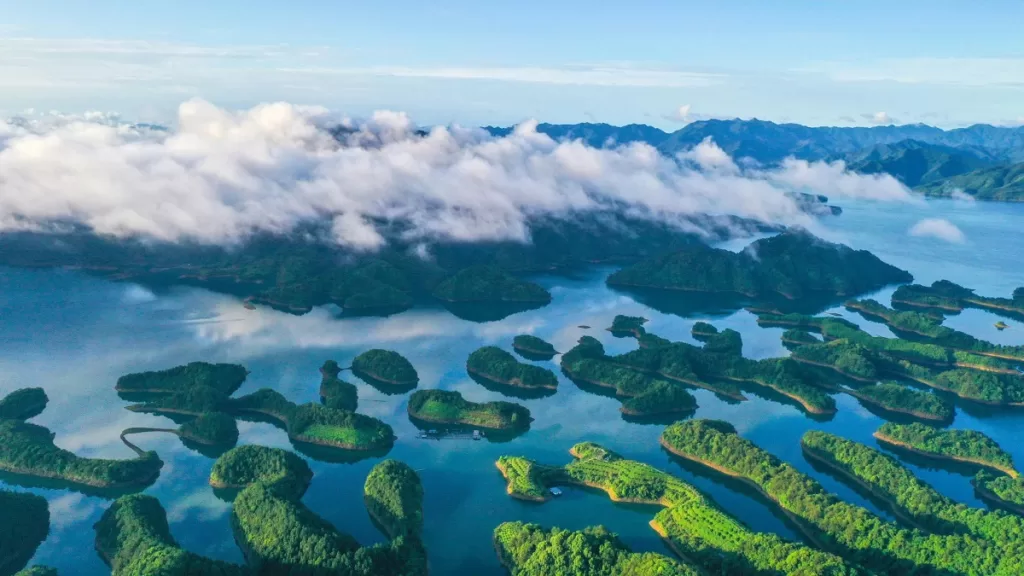Lingyin Temple (灵隐寺), located in Hangzhou, is one of the oldest and most significant Buddhist temples in the region, with its origins dating back to the first year of the Xianhe era in the Eastern Jin Dynasty (326 AD). Founded by the eminent monk Hui Li from West India, the temple has undergone multiple expansions throughout its long history.
During the Shunzhi period of the Qing Dynasty, the Zen master Jude led the reconstruction of Lingyin Temple. The ambitious project, focused on the construction of halls and pavilions, spanned an impressive eighteen years, solidifying its status as the “southeastern crown.” In 1689, during Emperor Kangxi’s southern inspection tour, the temple was bestowed the name “Yunlin Chan Monastery” by the emperor himself.
Lingyin Temple holds immense cultural and historical significance, having weathered over seventeen centuries. The Heavenly King Hall proudly displays a plaque with the inscription “Yunlin Chan Monastery (云林禅寺),” personally penned by Emperor Kangxi. The stone pagoda in front of the Mahavira Hall and the stone scripture pillar in front of the Heavenly King Hall are relics from the Wu Yue period of the Five Dynasties and Ten Kingdoms.
The temple is a treasure trove of Buddhist artifacts, including ancient palm-leaf manuscripts, a gilded Buddha statue from the Eastern Wei Dynasty, a handwritten copy of the “Diamond Sutra” by Dong Qichang from the Ming Dynasty, and a woodblock-printed dragon scripture from the Qing Dynasty. Lingyin Temple is also renowned as the place where Ji Gong, a legendary monk, entered the monastic life, and it is believed to possess great spiritual efficacy, attracting a continuous stream of devotees seeking blessings and offering prayers daily.
Table of Contents
- Basic Information
- Location and Transportation
- Highlights of Lingyin Temple
- Vlog about Lingyin Temple
- Attractions near Lingyin Temple
- Other Iconic Attractions in Hangzhou
Basic Information
| Estimated Length of Tour | 2 – 3 hours |
| Ticket Price | Fei Lai Feng: 45 RMB Lingyin Temple: 30 RMB To enter Lingyin Temple, you must get the ticket for Fei Lai Feng first |
| Opening Hours | 6.30 – 17.30 |
| Telephone Number | 0086-0571-87968665 |
Location and Transportation
Lingyin Temple is situated at 1 Fayun Lane, Lingyin Road, Xihu District, Hangzhou, Zhejiang Province, China. Nestled in the serene surroundings of Xihu District, the temple is embraced by the North Peak and faces the picturesque Fei Lai Feng, creating a tranquil and spiritually enriching location. To get there, you can take bus 103, 121, 324M, or 1314 and get off at Lingyin East Stop (灵隐东站).
Highlights of Lingyin Temple
Fei Lai Feng (Peak Flown from Afar)

One of the standout features of Lingyin Temple is the impressive collection of stone carvings in Fei Lai Feng, or Peak Flown from Afar. This extensive array of Buddha statues, carved into limestone cliffs, spans from the Five Dynasties and Ten Kingdoms period to the Ming Dynasty. Among the more than 470 statues, 335 remain relatively intact, making them exceptionally precious. Notable among these are the earliest statues – depicting Maitreya, Avalokiteshvara, and Mahasthamaprapta – carved on the right side of the entrance to the Qinglin Cave in 951 AD. Additionally, the bas-relief carving of the Luohan Assembly from the Northern Song Dynasty stands out as a masterpiece of sculptural artistry.
One of the most famous attractions is the colossal Maitreya Buddha and the group of 18 Arhats. This ensemble represents the largest rock-carved Maitreya statue at Fei Lai Feng and is also the earliest of its kind in China. Surrounding the Maitreya are the 18 Arhats, each with distinctive expressions and lifelike details. The stone carvings from the Yuan Dynasty, featuring over 100 statues in a mix of Han and Tibetan styles, are known for their gracefulness and elegance, making them treasures in Buddhist art.
Heavenly King Hall

The Heavenly King Hall, with dimensions approximately 24 meters long and 15 meters wide, is a focal point within Lingyin Temple. In the central niche facing the mountain gate, a seated Maitreya Buddha is enshrined. The Buddha is depicted with a bare chest and a smiling countenance, seated on a lotus cushion. Behind the mountain gate, another niche houses a sculpture of the Buddhist guardian deity, Weituo, standing at two and a half meters tall. This precious sculpture, carved from camphor wood during the Southern Song Dynasty, has endured for over 700 years.
Flanking the Heavenly King Hall are four large, vividly colored statues of the Four Heavenly Kings, each standing at a height of eight meters and clad in heavy armor. Two of them exude a mighty presence, while the other two display fierce expressions, collectively known as the Four Heavenly Guardians. Above the hall hangs a prominent plaque with the inscription “Yunlin Chan Monastery,” personally bestowed by Emperor Kangxi of the Qing Dynasty.
Mahavira Hall

The Mahavira Hall, originally named the Hall of Supreme Awakening (觉皇殿), stands as a monumental structure within Lingyin Temple. Stretching approximately 24 meters in length and adorned with a multi-eaved roof towering 33.6 meters high, the hall is a captivating showcase of architectural grandeur. At the heart of the hall, an imposing 24.8-meter-high seated statue of Shakyamuni Buddha takes center stage. Crafted from fragrant camphor wood, this statue is among the tallest wooden seated Buddha figures in China, representing a rare and invaluable masterpiece of religious art.
Flanking the central Buddha are twenty standing statues of celestial deities, while the rear sides feature twelve seated Buddhas in various states of enlightenment. The rear wall of the Mahavira Hall is adorned with a three-dimensional sculptural ensemble depicting the compassionate act of universal salvation known as “Cihang Pudu” and the pilgrimage to fifty-three islands. This intricate display includes 150 Buddha statues, with a central statue of Guanyin riding on a turtle, holding a vessel of pure water to aid sentient beings. Flanking Guanyin are the disciples Shancai and the Dragon Girl, with the presence of Ksitigarbha Bodhisattva above them, all set against a backdrop portraying Shakyamuni’s snowy mountain retreat.
The front terrace of the Mahavira Hall features two octagonal nine-tiered stone pagodas, each over seven meters tall. Expertly carved on each face, these pagodas were determined by renowned architectural expert Liang Sicheng to have been crafted in the waning years of the Wuyue Kingdom, around 969 AD.
Pharmacist Hall

The Pharmacist Hall, Lingyin Temple’s third major hall, spans approximately 20 meters in length and 12 meters in width. It is dedicated to the “Three Saints of the East”: the Medicine Buddha and the Sun and Moon Deities. The central figure, seated on a lotus throne, is the Medicine Buddha, known as the “Great Medicine King Buddha.” He is revered for alleviating suffering, bringing joy, and dispelling illness and calamities. Standing to the left is the Sunlight Bodhisattva, holding the sun, symbolizing illumination, while on the right stands the Moonlight Bodhisattva, cradling the moon, symbolizing coolness.
The hall is adorned with twelve statues of the Medicine Buddha’s disciples, known as the “Medicine Boys” or “Yaksha Generals.” These formidable figures, equipped with helmets and armor, exude strength and command seven thousand heavenly soldiers each. Positioned according to the twelve hours of the day, they serve as protectors and emissaries in the divine realm.
Lingyin Copper Hall

Nestled within the Five Hundred Arhats Hall is the awe-inspiring “Lingyin Copper Hall,” soaring to a remarkable height of 12.62 meters. This architectural masterpiece claims the title of China’s tallest copper hall and has secured a prestigious place in the Guinness World Records as the highest of its kind. The design and execution of the “Lingyin Copper Hall” were entrusted to the renowned Chinese arts and crafts master Zhu Bingren by the Hangzhou Buddhist Association. After eight revisions and over 400 days of meticulous craftsmanship, this single-tier, double-eaved, hip-and-gable-roofed traditional structure emerged.
Adorned with flying eaves, intricately carved tiles, and expansive wings spanning 7.77 meters, the hall boasts a majestic presence. Its base is paved with copper bricks, and the pedestal features classic Buddhist paintings casting a spiritual ambiance.
Buddhist Ceremonies and Cultural Events

Lingyin Temple hosts various Buddhist ceremonies and cultural events that enrich the spiritual experience for visitors:
- Laba Festival: On the day of the Laba Festival (8th of December in Chinese Lunar Year), the temple organizes grand ceremonies, blessing rituals, and lectures by the abbot, creating a series of cultural activities in celebration of this auspicious day.
- Water and Land Dharma Assembly: Annually in the ninth lunar month, Lingyin Temple conducts the Water and Land Dharma Assembly. This is one of the most elaborate and auspicious Buddhist ceremonies in Chinese Buddhism. Spanning seven days, the assembly includes chanting of scriptures, repentance rituals, and other Buddhist practices. It serves as an opportunity for believers to pray for blessings, seek protection from disasters, and dedicate merits to ancestors and departed souls.
These events not only showcase the temple’s commitment to religious practices but also provide a cultural gateway for visitors to immerse themselves in the traditions and spirituality of Lingyin Temple.









